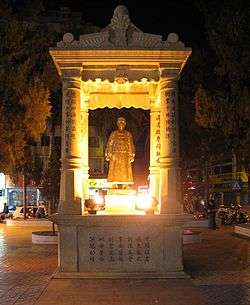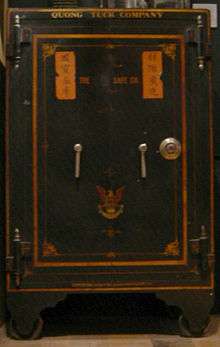Chin Gee Hee
Chin Gee Hee (June 22, 1844[2] – 1929), courtesy name Chàngtíng (暢庭),[3] Cheun Gee Yee,[4] was a Chinese merchant, labor contractor, and railway entrepreneur, who made his fortune in Seattle, Washington[5] before returning to his native village in Guangdong province, where he continued his successes.
| Chin Gee Hee | |||||||
|---|---|---|---|---|---|---|---|
.jpeg) Chin Gee Hee in his office in Seattle circa 1904 | |||||||
| Traditional Chinese | 陳宜禧 | ||||||
| Simplified Chinese | 陈宜禧[1] | ||||||
| |||||||
Life
Born the son of a maker of soy sauce crocks in a village in what is now the city of Taishan,[lower-alpha 1] Chin came to the attention of an old man[lower-alpha 2] because of his calm after some other boys smashed crocks that he was carrying to market. The man brought him along on his passage to America, where Chin worked in a placer mine before making his way to Port Gamble, Washington, where he worked in a lumber mill.[5][8]
While still in North Kitsap, he learned a reasonable amount of English, and made friends with several Suquamish, including the family of Chief Seattle. He also met and befriended Henry Yesler, owner of a mill in the young city of Seattle, who convinced him to move there.[3]

In 1873,[9] he arrived in Seattle, a settlement that was about 20 years old at the time. After meeting Chin Chun Hock (Chinese: 陳程學; pinyin: Chén Chéngxué), who was from the same village in Taishan, he became a junior partner in the Wa Chong company (Chinese: 華昌; pinyin: Huá Chāng, "Chinese Prosperity"),[1] the city's leading Chinese enterprise of the time. The Wa Chong company imported or manufactured goods including sugar, tea, rice, cigars, opium (legal at the time), and fireworks.[3][5]
At the time, there were few Chinese women in America.[5] While still in North Kitsap, Chin imported a wife from China. Their son Chin Lem (Chinese: 陳霖; pinyin: Chén Lín), later known as Tew Dong (Chinese: 秋宗; pinyin: Qiūzōng), born 1875 in Seattle, was the first known Chinese child born in Washington Territory (now Washington State).[3][5]
At the Wa Chong company, he acquired labor contracts from coal mines, railroads, farming, and the Puget Sound mosquito fleet. As one of the major labor suppliers for Northern Pacific Railway in the Puget Sound district, Chin also helped with payroll and discipline of the Chinese labor.[10] He also placed Chinese house-boys and cooks. His partnership with Chin Ching-hock was somewhat uneasy: Chin Ching-hock was more interested in imports and exports than in the labor contracting that became Chin Gee Hee's specialty.[11]
Chin Gee Hee was a central figure in the efforts at political and diplomatic defense against the anti-Chinese riots of November 1885. During the crisis, he represented the community and exchanged telegrams with Chinese consul general Ow-yang Ming (Chinese: 歐陽明; pinyin: Ōuyáng Míng) in San Francisco, California. He kept careful records of damages to Chinese businesses, and, partly as a result, Seattle's Chinese community fared far better than that of neighboring Tacoma, ultimately remaining in the city and collecting $700,000 in damages through a favorable ruling by judge Thomas Burke.[5][12]

In 1888, he set up independently as a labor contractor, with his Quong Tuck Company[13] (also known as Quong Tuck Lung Company)[14] or Quon Tuck Company[15] supplying construction workers to railways (the Great Northern Railway, the Seattle and Walla Walla Railroad and Transportation Company) and to Seattle's regrading projects.[12] He provided work crews (and was involved entrepreneurially) in rail lines along what are now Alaskan Way (along the Seattle waterfront) and a cable car perpendicular to the waterfront along Yesler Way as far as 14th Avenue.[5][12] He also provided Chinese masons to help build the Burke Building, a full city block at Second Avenue and Marion Street.[lower-alpha 3] His own building at Second and Washington, the Canton Building (also known as the Chin Gee Hee Building, now the Kon Yick Building), 208-210 S. Washington Street,[14][15] was among the first brick buildings[17] raised after the Great Seattle Fire of June 6, 1889. It was shared with the Bow Tai Wo Company.[12] (As of 2007, the building is still standing, though much altered; in particular, a 1928 re-routing of Second Avenue S. removed a corner of the building.)[5]
He passed his Seattle business on to his son, Chin Lem, and son-in-law Woo Quon-bing (Chinese: 胡冠炳; pinyin: Hú Guānbǐng)[14][18] and returned in 1904 or 1905[19] to China, where he was the entrepreneur behind South China's first railway and founded a seaport, while continuing also to have business associations with Seattle.[5] He returned frequently to the U.S. and, in particular, to Seattle, where he retained close ties, and which he last visited in 1922.[20]
His railway was known as the Sun Ning Railway Company. He raised $2.75 million, mainly from overseas Chinese;[2][21] Chin's partner Yu Zhuo (Chinese: 余灼; pinyin: Yú Zhuó; also variously rendered as Yu Shek)[3] or Yu Chuek[22] raised further funds in China and from overseas Chinese in Southeast Asia. The Sun Ning was the Pearl River Delta's first major railway. Its benefits to Guangdong's economy were cut short when it was seized by local warlords in 1926; it was finally destroyed during the Second Sino-Japanese War in 1938.[2][5][14][23]
While in China, Chin also served as a connection for the Seattle China Club.[24] Members of the China Club, which advocated for increased trade between China and Seattle, were invited to attend the opening of Chin's port in Guangdong.[24]
Notes
- Sources variously refer to the village as "Look Tun","Look Tun",[6] "Langmei village, Doushan town",[2] or "Long-mei" (Chinese: 朗美; pinyin: Lǎngměi) "of Luk-choon" (Chinese: 六村; pinyin: Liù Cūn; possibly meaning "Sixth Village")],.[3] There is more information in post #59 at the blog page.[7]
- Willard Jue gives the man's name as Hung-bok 宏伯 (pinyin: Hongbo)[3]
- Torn down in 1971 to build what is now Seattle's Henry M. Jackson Federal Building; one arch of the Burke Building remains as a memorial).[12][16]
- Chin Chun Hock; unsigned note on a blog, but presumably trustworthy for transliteration of names.
- The History of Xinning Railway Archived 2016-01-30 at the Wayback Machine, Bureau of Archives of Taishan City.
- Jue 1983, p. 32.
- "Peter Crush, Hong Kong Railway Society. Accessed online 22 September 2007. Select :English, Member's Corner, Feature Articles, Sunning Railway". Archived from the original on 11 March 2007. Retrieved 23 September 2007.
- Scigliano 2007
- Guide to the Willard G. Jue Papers, 1880-1983 on the site of the University of Washington Libraries says that the Sun Ning railroad went to his native village.
- "Archived copy". Archived from the original on 2011-07-26. Retrieved 2007-07-19.CS1 maint: archived copy as title (link)
- Jue 1983, p. 32 says he was in Port Gamble in 1862.
- So say Scigliano and Willard Jue (1983). The Guide to the Willard G. Jue Papers, 1880-1983 on the site of the University of Washington Libraries, accessed July 19, 2007, says he acquired his Wa Chong partnership in 1868, but they give no citation, and Jue himself says he became a partner only after moving to Seattle.
- Chang, Kornel (June 2012). American Crossroads : Pacific Connections : The Making of the U.S.-Canadian Borderlands. University of California Press. p. 36. ISBN 9780520271685.
- Jue 1983, p. 32–33.
- Jue 1983, p. 33.
- Walt Crowley, Seattle Neighborhoods: Chinatown-International District -- Thumbnail History, HistoryLink.org Essay 1058, May 3, 1999. Accessed online July 19, 2007.
- Guide to the Willard G. Jue Papers, 1880-1983 on the site of the University of Washington Libraries
- Summary for 400 2nd Avenue Extension / Parcel ID 5247800980, Seattle Department of Neighborhoods. Accessed online August 4, 2007.
- Henry M. Jackson Federal Building, Emporis.com, accessed 28 September 2007.
- Scigliano says "the first"; Crowley and Jue are more cautious.
- Jue 1983, p. 34.
- The History of Xinning Railway Archived 2004-12-10 at the Wayback Machine, Bureau of Archives of Taishan City and Xiao-huang Yin & Zhiyong Lan say 1904; Scigliano says 1905
- Jue 1983, p. 35.
- Some sources—Eric Scigliano, for example—say that further investment came from James J. Hill, but others say that he "vowed not to sell shares to foreigners, to borrow money from them, or to use their engineers." Jue (1983), p. 34, says that Chen "traveled all over the United States and Canada with the help of J. J. Hill, President of the Great Northern Railway Co.," but does not speak of Hill investing in his own right.
- [Yung et al. 2006], editors' note, p. 125.
- Xiao-huang Yin & Zhiyong Lan (2003), p. 9.
- Chang, Kornel S. (2012). Pacific connections : the making of the U.S.-Canadian borderlands. Berkeley: University of California Press. p. 183. ISBN 9780520271685.
References
- Chin Gee Hee, "Letter Asking for Support to Build the Sunning Railroad" (1911), p. 125–128 in Judy Yung, Gordon H. Chang, and Him Mark Lai (compilers and editors), Chinese American Voices, University of California Press (2006). ISBN 0-520-24310-2.
- Willard G. Jue, "Chin Gee-hee, Chinese Pioneer Entrepreneur in Seattle and Toishan", The Annals of the Chinese Historical Society of the Pacific Northwest, 1983, 31:38.
- Also, Guide to the Willard G. Jue Papers, 1880-1983 on the site of the University of Washington Libraries, accessed July 19, 2007.
- Douglas C. Sackman, "Pacific World Passages: The Traffic in Trees and the Transformation of Space in Puget Sound, 1850-1900", a paper presented at the American Society for Environmental History Annual Meeting, Victoria, BC, April 3, 2004, especially the section "III. Workers of the Pacific World: Logging and Labor in & around the Mills". Draft available online, accessed July 30, 2007; there is no formally published form as of that date.
- Eric Scigliano, "Seattle's Chinese Founding Father", Seattle Metropolitan, May 2007, p. 48.
- Xiao-huang Yin & Zhiyong Lan, Why Do They Give? Change and Continuity in Chinese American Transnational Philanthropy since the 1970s, commissioned by the Global Equity Initiative for a workshop on Diaspora Philanthropy to China and India, held in May 2003. p. 9. Accessed online 22 September 2007.
- Draft History of the Qing Dynasty, vol. 150.
- The History of Xinning Railway, Bureau of Archives of Taishan City. Undated; the Internet Archive shows the page already existing at the Wayback Machine (archived December 10, 2004) December 10, 2004. Accessed online 22 September 2007.
- Page on Seattle’s Chinatown - International District on cwok.com, content attributed to the Wing Luke Museum. Accessed online July 19, 2007.
- Chinese Emigration, the Sunning Railway and the Development of Toisan by Lucie Cheng and Liu Yuzun with Zheng Dehua, Amerasia 9(1): 59-74, 1982.
- Kornel Chang, "American Crossroads: Pacific Connections: The Making of the U.S.-Canadian Borderlands" Berkeley: University of California Press, 2012. ISBN 978-0-520-27169-2.
External links
| Wikimedia Commons has media related to Chin Gee Hee. |
- David Takami, Chinese Americans HistoryLink.org Essay 2060, February 17, 1999, includes two photos of Chin.
